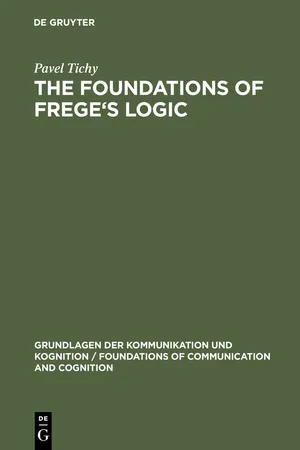
This is a test
- 316 pages
- English
- PDF
- Available on iOS & Android
eBook - PDF
The Foundations of Frege's Logic
Book details
Table of contents
Citations
Frequently asked questions
At the moment all of our mobile-responsive ePub books are available to download via the app. Most of our PDFs are also available to download and we're working on making the final remaining ones downloadable now. Learn more here.
Both plans give you full access to the library and all of Perlego’s features. The only differences are the price and subscription period: With the annual plan you’ll save around 30% compared to 12 months on the monthly plan.
We are an online textbook subscription service, where you can get access to an entire online library for less than the price of a single book per month. With over 1 million books across 1000+ topics, we’ve got you covered! Learn more here.
Look out for the read-aloud symbol on your next book to see if you can listen to it. The read-aloud tool reads text aloud for you, highlighting the text as it is being read. You can pause it, speed it up and slow it down. Learn more here.
Yes, you can access The Foundations of Frege's Logic by Pavel Tichy in PDF and/or ePUB format, as well as other popular books in Philosophy & Philosophy History & Theory. We have over one million books available in our catalogue for you to explore.
Information
Table of contents
- Preface
- Acknowledgements
- Chapter One: Constructions
- 1. Entities, constructions, and functions
- 2. Two views of arithmetic
- 3. The linguistic turn
- ChapterTwo: Fregean Functions
- 4. Frege and constructions
- 5. Functions as structured entities
- 6. The Extensionality Thesis
- 7. Unsaturatedness
- 8. The Immediacy Thesis
- Chapter Three: Fregean Objects
- 9. Objects as their own constructions
- 10. Objects as meta-constructions
- 11. Multiple analyses
- Chapter Four: Variables
- 12. Russell’s Paradox
- 13. The Vicious Circle Principle
- 14. An objectual notion of variable
- Chapter Five: A Hierarchy of Entities
- 15. The five modes of forming constructions
- 16. The ramified hierarchy
- 17. Substitution
- Chapter Six: Two Interpretations of the Concept Script
- 18. The syntax of the Concept Script
- 19. Interpretation A
- 20. Interpretation B
- 21. The ambiguity embraced
- Chapter Seven: Senses and Presentations
- 22. The ambiguity
- 23. Rigid presentations
- 24. Indexicals
- Chapter Eight: The Mediacy Thesis
- 25. The discrepancy
- 26. The definite article
- 27. Oblique reference
- Chapter Nine: Disambiguating Natural Discourse
- 28. Context dependence
- 29. The asymmetry argument
- 30. Russell’s Theory of Descriptions
- Chapter Ten: Church’s Logic of Sense and Denotation
- 31. Disambiguating with the grain
- 32. Church’s system rectified
- 33. Assertion
- 34. The cross-reference problem
- Chapter Eleven: Logical Space
- 35. The nature of determiners
- 36. Possible worlds
- 37. The temporal dimension
- 38. Epistemic framework
- Chapter Twelve: Transparent Intensional Logic
- 39. Application
- 40. Aboutness
- 41. De dicto and de re
- 42. The limitations of logical space
- 43. Constructional attitudes: aboutness revisited
- 44. Codes and languages
- Chapter Thirteen: Inference
- 45. The two views
- 46. ‘Natural deduction’
- 47. Sequents
- Chapter Fourteen: The Fallacy of Subject Matter
- 48. ‘Arbitrary objects’
- 49. Fictional and historic reference
- 50. ‘Formal axiomatics’
- 51. Epilogue
- Appendices
- Bibliography
- Index of Names
- Index of Subjects